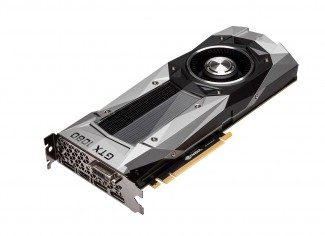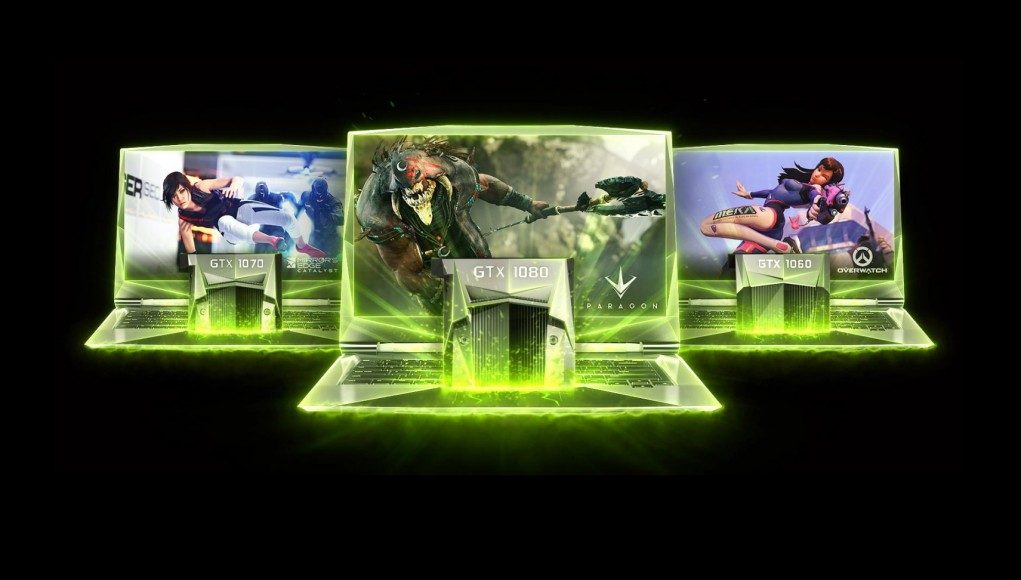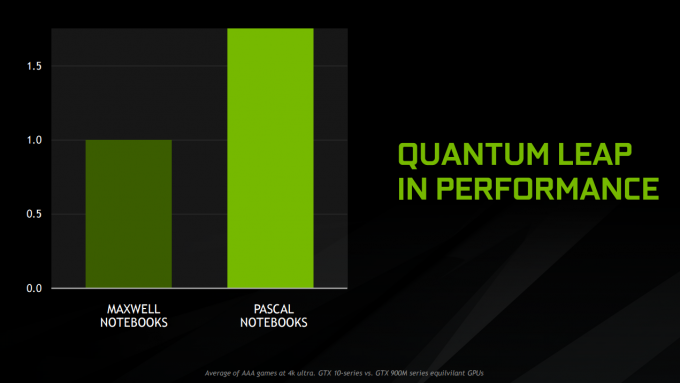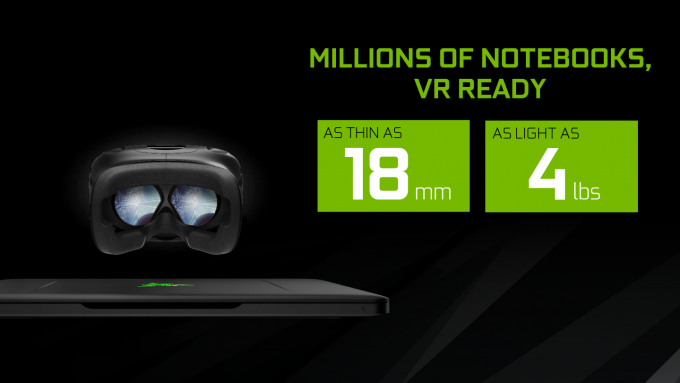Today NVIDIA has revealed that its 10-Series GPUs—the GTX 1080, 1070, and 1060—are coming to gaming notebooks from a slew of major computer manufacturers. The company says the GPUs are not mobile variants, but desktop-class chips which will mean widespread availability of ‘VR Ready’ laptops.
In years past, Nvidia has launched similarly named versions of their desktop cards with an appended ‘M’, meaning a less powerful mobile version of the namesake, designed to fit within the space, power, and heat limitations of a notebook.

With the company’s last generation of GPUs, the launch of a full-bore GTX 980 in select notebooks was a watershed moment for mobile PC gaming last September. This Maxwell-based GPU dropped that ‘M’ designation found on GeForce notebooks, being almost identical in specification and performance to a desktop GTX 980.
Until today, the GTX 980 has remained the most powerful notebook GPU, and the only one truly viable for high-end VR. But thanks to the efficiencies of the company’s 10-Series ‘Pascal’ architecture, Nvidia is launching three VR Ready GPUs for use in notebooks: the GTX 1080, 1070 and 1060.
You won’t find any ‘M’ attached to these names; Nvidia claims that the chips are within 10% of the performance of their desktop-class brethren—in some cases equal, or even faster. Indeed, in the case of the GTX 1070 variant, it sports more CUDA cores than the desktop GTX 1070, albeit at a slightly lower clock speed. As such, all three new notebook GPUs have been classed as VR Ready, fully supporting Nvidia’s VRWorks technologies, which is great news when you start to consider the thermal envelopes relative to the previous generation:
| GTX 1080 | GTX 1070 | GTX 1060 | |
| CUDA Cores | 2560 | 2048 | 1280 |
| Boost Clock | 1733 MHz | 1645 MHz | 1670 MHz |
| Memory Config | 8GB, 10 Gbps (GDDR5X) | 8GB, 8 Gbps (GDDR 5) | 6 GB, 8 Gbps (GDDR5) |
| TDP | “similar to GTX 980” | “similar to GTX 980M” | “similar to GTX 970M” |
Laptops equipped with these processors will start at $1,300, Nvidia says. With claimed desktop-class performance, mobile PC gaming—and even mobile VR for that matter—may simply no longer be the major compromise it once was. The company further says that the mobile GTX 1080 and 1070 will support SLI.
At an event highlight the new gaming notebook GPUS, Nvidia referred to the gaming notebook market as the ‘fastest growing gaming platform’, with +30% sales growth over 3.5 years, compared to -4% and +4% for the Xbox One and PlayStation 4 respectively over the same period.
Nvidia says every major gaming notebook OEM is expected to launch VR Ready systems equipped with 10-series GPUs. the company claims this is the biggest leap in performance in a single GTX generation, and further cements their total dominance of the notebook GPU market which they say holds a 95% market share.
Portability is going to be a huge boon for VR enthusiasts who need to travel; perhaps the GTX 1060 is the most interesting of the three chips, as it will be available in some impressively thin and light designs (as thin and light as 18mm and 4lbs), and opens up further potential for ‘wireless’ VR backpack solutions. Nvidia says this will lead to millions of VR Ready notebooks entering the market.
While the ‘VR Ready’ branding only applies to the notebooks when plugged in, our understanding is that there’s no reason why the power management settings can’t be adjusted to achieve the same level of performance on battery, albeit at the expense of run time, for some fully ‘untethered’ VR. That said, we can expect 30% more battery life in general from these Pascal chips compared to Maxwell, thanks in part to some refinements to the BatteryBoost technology, which will also be updated soon for GTX800M and higher GPUs.
But this certainly isn’t just about VR. The new level of performance has prompted a big step forward in display technologies for gaming notebooks, and you can expect to see a large number of interesting configurations, including G-Sync at 1440p, 120Hz 1080p displays, and 4K. We were treated to a live demo of Gears of War 4 (confirmed to support DX12, G-Sync, 4K and dynamic resolution), running on a giant 4K OLED TV, powered by a GTX 1080 notebook running at 4K on Ultra settings; hugely impressive, and it never skipped a beat.

With a GTX 1080 notebook (i7-6700HQ, 16GB RAM), demanding titles such as Mirror’s Edge Catalyst, Overwatch, Doom, Rise of the Tomb Raider, and Metro Last Light all comfortably stay above 120Hz at 1080p on Ultra settings, and they all hold above 50fps at 4K, Nvidia says.
Overclocking on Pascal has much greater potential than previous generations; where you might have struggled to find a comfortable 100MHz increase with a Maxwell notebook, you can expect Pascal to reach above 200MHz or even 300MHz in some cases. This is all thanks to the improvements in electrical design: a Dual-FET power supply (higher density), multi-phased power controllers (higher efficiency), along with factory overclocking support. At the event we were given a live demo of Doom on a GTX 1080 notebook, showing a stable overclock at 2GHz, which appeared to be holding at a remarkable 73 degrees celsius.
All in all, it’s an exciting time for notebooks, a significant step forward in improving VR’s practicality, and perhaps most importantly, we should see the widest ever selection of VR Ready and high-performance gaming designs and specifications over the next few months.
Disclosure: Nvidia paid for accommodations for one Road to VR correspondent to attend an event where information for this article was gathered.









